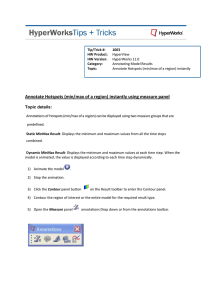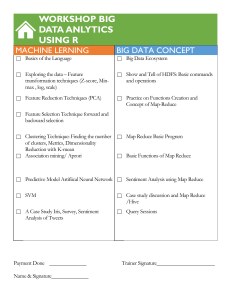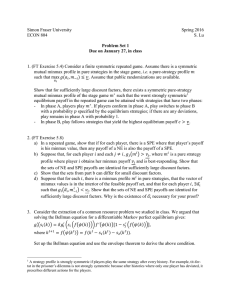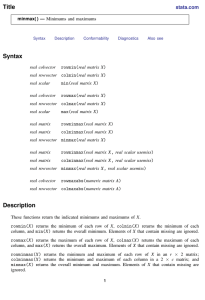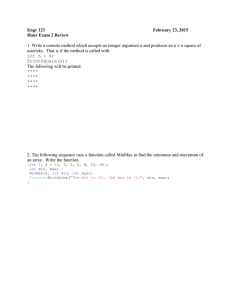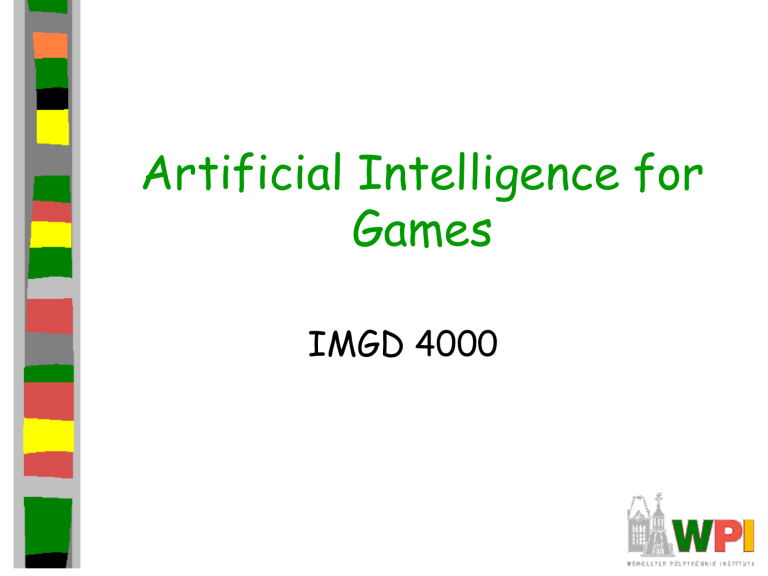
Artificial Intelligence for
Games
IMGD 4000
Introduction to Artificial Intelligence
(AI)
•
•
•
•
•
Many applications for AI
– Computer vision, natural language processing, speech
recognition, search …
But games are some of the more interesting
Opponents that are challenging, or allies that are
helpful
– Unit that is credited with acting on own
Human-level intelligence too hard
– But under narrow circumstances can do pretty well
(ex: chess and Deep Blue)
– For many games, often constrained (by game rules)
Artificial Intelligence (around in CS for some
time)
AI for CS different than AI for Games
•
Must be smart, but purposely flawed
•
No unintended weaknesses
•
•
Must perform in real time (CPU)
Configurable by designers
•
“Amount” and type of AI for game can vary
– Loose in a fun, challenging way
– No “golden path” to defeat
– Must not look dumb
– Not hard coded by programmer
– RTS needs global strategy, FPS needs modeling of
individual units at “footstep” level
– RTS most demanding: 3 full-time AI programmers
– Puzzle, street fighting: 1 part-time AI programmer
– All of project 2.
Outline
• Introduction
• MinMax
• Agents
• Finite State Machines
• Common AI Techniques
• Promising AI Techniques
(done)
(next)
MinMax - Links
• Minimax Game Trees
• Minimax Explained
• Min-Max Search
• Wiki
• (See Project 2 Web page)
MinMax - Overview
•
•
•
•
MinMax the heart of almost every computer board
game
Applies to games where:
– Players take turns
– Have perfect information
• Chess, Checkers, Tactics
But can work for games without perfect
information or chance
– Poker, Monopoly, Dice
Can work in real-time (ie- not turn based) with
timer (iterative deepening, later)
•
•
•
•
MinMax - Overview
Search tree
– Squares represent decision states (ie- after a move)
– Branches are decisions (ie- the move)
– Start at root
– Nodes at end are leaf nodes
– Ex: Tic-Tac-Toe (symmetrical positions removed)
Unlike binary trees can have any number of children
– Depends on the game situation
Levels usually called plies (a ply is one level)
– Each ply is where "turn" switches to other player
Players called Min and Max (next)
MaxMin - Algorithm
•
•
•
•
•
Named MinMax because of algorithm behind data
structure
Assign points to the outcome of a game
– Ex: Tic-Tac-Toe: X wins, value of 1. O wins, value -1.
Max (X) tries to maximize point value, while Min
(O) tries to minimize point value
Assume both players play to best of their ability
– Always make a move to minimize or maximize points
So, in choosing, Max will choose best move to get
highest points, assuming Min will choose best move
to get lowest points
MinMax – First Example
•
•
•
•
•
Max’s turn
Would like the “9” points (the
maximum)
But if choose left branch, Min
will choose move to get 3
left branch has a value
of 3
If choose right, Min can
choose any one of 5, 6 or 7
(will choose 5, the minimum)
right branch has a
value of 5
Right branch is largest (the
maximum) so choose that
move
5
Max
Min
3
4
5
3 9
4
5 6 7
Max
MinMax – Second Example
Max
Min
Max
Min
•
•
•
•
•
•
Max’s turn
Circles represent Max, Squares represent Min
Values inside represent the value the MinMax algorithm
Red arrows represent the chosen move
Numbers on left represent tree depth
Blue arrow is the chosen move
MinMax and Chess
•
•
With full tree, can determine best possible move
However, full tree impossible for some games! Ex: Chess
– At a given time, chess has ~ 35 legal moves. Exponential
growth:
• 35 at one ply, 352 = 1225 at two plies … 356 = 2 billion and 3510
= 2 quadrillion
•
•
– Games can last 40 moves (or more), so 3540 … Stars in
universe: ~ 228
For large games (Chess) can’t see end of the game. Must
estimate winning or losing from top portion
– Evaluate() function to guess end given board
– A numeric value, much smaller than victory (ie- Checkmate
for Max will be one million, for Min minus one million)
So, computer’s strength at chess comes from:
– How deep can search
– How well can evaluate a board position
– (In some sense, like a human – a chess grand master can
evaluate board better and can look further ahead)
MinMax – Pseudo Code (1 of 3)
int MinMax(int depth) {
// White is Max, Black is Min
if (turn == WHITE)
return Max(depth);
else
return Min(depth);
}
• Then, call with:
value = MinMax(5); // search 5 plies
MinMax – Pseudo Code (2 of 3)
int Max(int depth) {
int best = -INFINITY; // first move is best
if (depth == 0)
return Evaluate();
GenerateLegalMoves();
while (MovesLeft()) {
MakeNextMove();
val = Min(depth – 1); // Min’s turn next
UnMakeMove();
if (val > best)
best = val;
}
return best;
}
MinMax – Pseudo Code (3 of 3)
int Min(int depth) {
int best = INFINITY; // different than MAX
if (depth == 0)
return Evaluate();
GenerateLegalMoves();
while (MovesLeft()) {
MakeNextMove();
val = Max(depth – 1); // Max’s turn next
UnMakeMove();
if (val < best) // different than MAX
best = val;
}
return best;
}
MinMax - Notes on Pseudo Code
•
•
Dual-recursive call each other until bottom out
(depth of zero is reached)
Try tracing with depth = 1
•
Need to modify to return best move. Implement:
•
– Essentially, try each move out, choose best
–
–
–
–
When store “best”, also store “move”
Use global variable
Pass in move via reference
Use object/structure with “best” + “move”
Since Max() and Min() are basically opposites
(zero-sum game), can make code shorter with
simple flip
– Called NegaMax
MinMax – NegaMax Pseudo Code
int NegaMax(int depth) {
int best = -INFINITY;
if (depth == 0)
return Evaluate();
GenerateLegalMoves();
while (MovesLeft()) {
MakeNextMove();
val = -1 * NegaMax(depth-1); // Note the -1
UnMakeMove();
if (val > best)
// Still pick largest
best = val;
}
return best;
}
• Note, the -1 causes Min to pick smallest, Max biggest
• Ex: 4, 5, 6 Max will pick ‘6’, while Min will pick ‘-4’ so ‘4’
MinMax – AlphaBeta Pruning
•
•
MinMax searches entire tree, even if in some cases the rest
can be ignored
Example – Enemy lost bet. Owes you one thing from bag.
You choose bag, but he chooses thing. Go through bags one
item at a time.
– First bag: Sox tickets, sandwich, $20
• He’ll choose sandwich
– Second bag: Dead fish, …
• He’ll choose fish.
•
Doesn’t matter if rest is car, $500,
Yankee’s tickets … Don’t need to look further. Can prune.
In general, stop evaluating move when find worse than
previously examined move
Does not benefit the player to play that move, it need
not be evaluated any further.
Save processing time without affecting final result
MinMax – AlphaBeta Pruning Example
• From Max point of view, 1 is already lower
than 4 or 5, so no need to evaluate 2 and 3
(bottom right) Prune
MinMax – AlphaBeta Pruning Idea
•
Two scores passed around in search
– Alpha – best score by some means
• Anything less than this is no use (can be pruned) since
we can already get alpha
• Minimum score Max will get
• Initially, negative infinity
– Beta – worst-case scenario for opponent
•
• Anything higher than this won’t be used by opponent
• Maximum score Min will get
• Initially, infinity
Recursion progresses, the "window" of Alpha-Beta
becomes smaller
– Beta < Alpha current position not result of best
play and can be pruned
MinMax – AlphaBeta Pseudo Code
int AlphaBeta(int depth, int alpha, int beta) {
if (depth <= 0)
return Evaluate();
GenerateLegalMoves();
while (MovesLeft()) {
MakeNextMove();
val = -1 * AlphaBeta(depth-1, -beta, -alpha);
UnMakeMove();
if (val >= beta)
return val;
if (val > alpha)
alpha = val;
}
return alpha;
}
• Note, beta and alpha are reversed for subsequent calls
• Note, the -1 for beta and alpha, too
MinMax – AlphaBeta Notes
• Benefits heavily dependent upon order
searched
– If always start at worst, never prune
• Ex: consider previous with node 1 first
(worst)
– If always start at best, branch at
approximated sqrt(branch)
• Ex: consider previous with 5 first (best)
• For Chess:
– If ~35 choices per ply, at best can improve
from 35 to 6
Allows search twice as deep
MinMax – Notes
•
•
Chess has many forced tactical situations (ie- taken knight,
better take other knight)
– MinMax can leave hanging (at tree depth)
– So, when done, check for captures only
Time to search can vary (depending upon Evaluate() and
branches and pruning)
– Instead, search 1 ply. Check time. If enough, search 2
plies. Repeat. Called iterative deepening
depth = 1;
while (1) {
Val = AlphaBeta(depth, -INF, INF)
If (timeOut()) break;
}
– For enhancement, can pass in best set of moves (line) seen
last iteration (principle variation)
MinMax – Evaluate()
•
•
Checkmate – worth more than rest combined
Typical, use weighted function:
– c1*material + c2*mobility + c3*king
safety + c4*center control + ...
– Simplest is point value for material
• pawn 1, knight 3, bishop 3, castle 3, queen 9
• All other stuff worth 1.5 pawns (ie- can ignore most
•
everything else)
What about a draw?
– Can be good (ie- if opponent is strong)
– Can be bad (ie- if opponent is weak)
– Adjust with contempt factor
• Makes a draw (0) slightly lower (play to win)
Outline
• Introduction
• MinMax
• Agents
• Finite State Machines
• Common AI Techniques
• Promising AI Techniques
(done)
(done)
(next)
Game Agents
• Most AI focuses around game agent
– think of agent as NPC, enemy, ally or neutral
• Loops through: sense-think-act cycle
– Acting is event specific, so talk about sense
and think first, then a bit on act
Sense
Think
Act
Game Agents – Sensing (1 of 2)
•
•
•
Gather current world state: barriers, opponents,
objects, …
Needs limitations: avoid “cheating” by looking at
game data
– Typically, same constraints as player (vision, hearing
range, etc.)
Vision
– Can be quite complicated (CPU intensive) to test
visibility (ie- if only part of an object visible)
– Compute vector to each object
• Check magnitude (ie- is it too far away?)
• Check angle (dot product) (ie- within 120° viewing
•
angle?)
Check if obscured. Most expensive, so do last.
Game Agents – Sensing (2 of 2)
•
Hearing
– Ex- tip-toe past, enemy doesn’t hear, but if run past,
enemy hears (stealth games, like Thief)
– Implement as event-driven
• When player performs action, notify agents within range
•
•
•
– Rather than sound reflection (complicated) usually
distance within bounded area
Can enhance with listen attributes by agent (if agent is
“keen eared” or paying attention)
Communication
– Model sensing data from other agents
– Can be instant (ie- connected by radio)
– Or via hearing (ie- shout)
Reaction times
– Sensing may take some time (ie- don’t have agent react
to alarm instantly, seems unrealistic)
– Build in delay. Implement with simple timer.
Game Agents – Thinking (1 of 3)
•
•
•
Evaluate information and make decision
As simple or elaborate as required
Generally, two ways:
1. Pre-coded expert knowledge
•
Typically hand-crafted “if-then” rules +
“randomness” to make unpredictable
2. Search algorithm for best (optimal)
solution
•
Ex- MinMax
Game Agents – Thinking (2 of 3)
•
Expert Knowledge
– Finite State Machines, decision trees, … (FSM most
popular, details next)
– Appealing since simple, natural, embodies common sense
and knowledge of domain
• Ex: See enemy weaker than you? Attack. See enemy
stronger? Go get help
– Trouble is, often does not scale
• Complex situations have many factors
• Add more rules, becomes brittle
– Still, often quite adequate for many AI tasks
• Many agents have quite narrow domain, so doesn’t matter
Game Agents – Thinking (3 of 3)
• Search
– Look ahead and see what move to do next
• Ex: piece on game board (MinMax), pathfinding
(A*)
– Works well with known information (ie- can
see obstacles, pieces on board)
• Machine learning
– Evaluate past actions, use for future action
– Techniques show promise, but typically too
slow
Game Agents – Acting (1 of 2)
• Learning and Remembering
– May not be important in many games where
agent short-lived (ie- enemy drone)
– But if alive for 30+ seconds, can be helpful
• ie- player attacks from right, so shield right
– Implementation - too avoid too much
information, can have fade from memory (by
time or by queue that becomes full)
Game Agents – Acting (2 of 2)
•
Making agents stupid
– Many cases, easy to make agents dominate
• Ex: FPS bot always makes head-shot
•
– Dumb down by giving “human” conditions, longer
reaction times, make unnecessarily vulnerable, have
make mistakes
Agent cheating
– Ideally, don’t have unfair advantage (such as more
attributes or more knowledge)
– But sometimes might “cheat” to make a challenge
• Remember, that’s the goal, AI lose in challenging way
– Best to let player know
AI for Games – Mini Outline
• Introduction
• MinMax
• Agents
• Finite State Machines
• Common AI Techniques
• Promising AI Techniques
(done)
(done)
(done)
(next)
Finite State Machines
•
•
•
Many different rules for agents
– Ex: sensing, thinking and acting when fighting, running,
exploring…
– Can be difficult to keep rules consistent!
Try Finite State Machine
– Probably most common game AI software pattern
– Natural correspondence between states and behaviors
– Easy: to diagram, program, debug
– General to any problem
– See AI Depot - FSM
For each situation, choose appropriate state
– Number of rules for each state is small
Finite State Machines
See Enemy
Wander
Attack
y
em
En
•
•
Flee
Abstract model of computation
Formally:
–
–
–
–
Lo
w
No
He
alt
h
No Enemy
(Do detailed
example next
slide)
Set of states
A starting state
An input vocabulary
A transition function that maps inputs and the
current state to a next state
Finite State Machines – Example (1 of 2)
•
•
•
Wander – move slowly,
randomly
Search – move faster, in
lines
Chasing – direct to player
Define transitions
– Close is 100 meters
(smell/sense)
– Visible is line of sight
Close by
Searching
Chasing
Hidden
•
Wandering
Far away
•
Game where raid Egyptian Tomb
Mummies! Behavior
– Spend all of eternity
wandering in tomb
– When player is close, search
– When see player, chase
Make separate states
– Define behavior in each state
Visible
•
•
Finite State Machines – Example (2 of 2)
•
Transition
– When player gets
scarab
– When timer expires
Can have sub-states
– Same transitions, but
different actions
• ie- range attack
versus melee attack
Close by
Searching
Visible
– Move away from
player fast
Wandering
Chasing
Scarab
Hidden
•
Can be extended easily
Ex: Add magical scarab
(amulet)
When player gets scarab,
Mummy is afraid. Runs.
Behavior
Far away
•
•
•
•
Afraid
Finite-State Machine: Approaches
• Three approaches
– Hardcoded (switch statement)
– Scripted
– Hybrid Approach
Finite-State Machine:
Hardcoded FSM
void Step(int *state) { // call by reference since state can change
switch(state) {
case 0: // Wander
Wander();
if( SeeEnemy() )
break;
{ *state = 1; }
case 1: // Attack
Attack();
if( LowOnHealth() ) { *state = 2; }
if( NoEnemy() )
{ *state = 0; }
break;
case 2: // Flee
Flee();
if( NoEnemy() )
break;
}
}
{ *state = 0; }
Finite-State Machine:
Problems with switch FSM
1. Code is ad hoc
– Language doesn’t enforce structure
2. Transitions result from polling (checking
each time)
– Inefficient – event-driven sometimes
better
• ie- when damage, call “pain” event for
monster and it may change states
3. Can’t determine 1st time state is entered
4. Can’t be edited or specified by game
designers or players
Finite State Machine
Alternative Implementation
• Make objects
• Transitions are events (passed by objects
creating events)
– Ex: player runs. All objects within hearing
range get “run sound” event
• Each object can have step event
– Gets mapped to right action in state by call
back
Finite-State Machine:
Scripted with Alternative Language
AgentFSM {
State( STATE_Wander )
OnUpdate
Execute( Wander )
if( SeeEnemy )
SetState(
OnEvent( AttackedByEnemy )
SetState( Attack )
State( STATE_Attack )
OnEnter
Execute( PrepareWeapon )
OnUpdate
Execute( Attack )
if( LowOnHealth ) SetState(
if( NoEnemy )
SetState(
OnExit
Execute( StoreWeapon )
State( STATE_Flee )
OnUpdate
Execute( Flee )
if( NoEnemy )
SetState(
}
STATE_Attack )
STATE_Flee )
STATE_Wander )
STATE_Wander )
Finite-State Machine:
Scripting Advantages
1. Structure enforced
2. Events can be handed as well as polling
3. OnEnter and OnExit concept exists
(If objects, when created or destroyed)
4. Can be authored by game designers
– Easier learning curve than straight C/C++
Finite-State Machine:
Scripting Disadvantages
•
•
Not trivial to implement
Several months of development of language
– Custom compiler
• With good compile-time error feedback
– Bytecode interpreter
•
• With good debugging hooks and support
Scripting languages often disliked by users
– Can never approach polish and robustness of
commercial compilers/debuggers
Finite-State Machine:
Hybrid Approach
•
•
•
Use a class and C-style macros to approximate a scripting
language
Allows FSM to be written completely in C++ leveraging
existing compiler/debugger
Capture important features/extensions
•
Can’t be edited by designers or players
–
–
–
–
–
–
–
OnEnter, OnExit
Timers
Handle events
Consistent regulated structure
Ability to log history
Modular, flexible, stack-based
Multiple FSMs, Concurrent FSMs
Finite-State Machine:
Extensions
•
Many possible extensions to basic FSM
– Event driven: OnEnter, OnExit
– Timers: transition after certain time
– Global state with sub-states (same transitions,
different actions)
– Stack-Based (states or entire FSMs)
• Easy to revert to previous states
• Good for resuming earlier action
– Multiple concurrent FSMs
• Lower layers for, say, obstacle avoidance – high
•
priority
Higher layers for, say, strategy
AI for Games – Mini Outline
• Introduction
• MinMax
• Agents
• Finite State Machines
• Common AI Techniques
• Promising AI Techniques
(done)
(done)
(done)
(done)
(next)
Common Game AI Techniques (1 of 4)
•
•
Whirlwind tour of common techniques
– For each, provide idea and example (where appropriate)
– Subset and grouped based on text
Movement
– Flocking
• Move groups of creatures in natural manner
• Each creature follows three simple rules
•
– Separation – steer to avoid crowding flock mates
– Alignment – steer to average flock heading
– Cohesion – steer to average position
Example – use for background creatures such as birds or
fish. Modification can use for swarming enemy
– Formations
• Like flocking, but units keep position relative to others
• Example – military formation (archers in the back)
•
Common Game AI Techniques (2 of 4)
Movement (continued)
– A* pathfinding
• Cheapest path through environment
• Directed search exploit knowledge about destination
•
•
•
to intelligently guide search
Fastest, widely used
Can provide information (ie- virtual breadcrumbs) so
can follow without recompute
See: http://www.antimodal.com/astar/
– Obstacle avoidance
• A* good for static terrain, but dynamic such as other
•
players, choke points, etc.
Example – same path for 4 units, but can predict
collisions so furthest back slow down, avoid narrow
bridget, etc.
Common Game AI Techniques (3 of 4)
•
Behavior organization
– Emergent behavior
• Create simple rules result in complex interactions
• Example: game of life, flocking
– Command hierarchy
• Deal with AI decisions at different levels
• Modeled after military hierarchy (ie- General does strategy
•
to Foot Soldier does fighting)
Example: Real-time or turn based strategy games -- overall
strategy, squad tactics, individual fighters
– Manager task assignment
• When individual units act individually, can perform poorly
• Instead, have manager make tasks, prioritize, assign to
•
units
Example: baseball – 1st priority to field ball, 2nd cover first
base, 3rd to backup fielder, 4th cover second base. All
players try, then disaster. Manager determines best person
for each. If hit towards 1st and 2nd, first baseman field
ball, pitcher cover first base, second basemen cover first
Common Game AI Techniques (4 of 4)
•
•
Influence map
– 2d representation of power in game
– Break into cells, where units in each cell are summed up
– Units have influence on neighbor cells (typically,
decrease with range)
– Insight into location and influence of forces
– Example – can be used to plan attacks to see where
enemy is weak or to fortify defenses. SimCity used to
show fire coverage, etc.
Level of Detail AI
– In graphics, polygonal detail less if object far away
– Same idea in AI – computation less if won’t be seen
– Example – vary update frequency of NPC based on
position from player
AI for Games – Mini Outline
• Introduction
• MinMax
• Agents
• Finite State Machines
• Common AI Techniques
• Promising AI Techniques
(done)
(done)
(done)
(done)
(done)
(next)
– Used in AI, but not (yet) in games
– Subset of what is in book
Promising AI Techniques (1 of 3)
•
•
Bayesian network
– A probabilistic graphical model with variables and
probable influences
– Example - calculate probability of patient having a
specific disease given symptoms
– Example – AI can infer if player has warplanes, etc.
based on what it sees in production so far
– Can be good to give “human-like” intelligence without
cheating or being too dumb
Decision tree learning
– Series of inputs (usually game state) mapped to output
(usually thing want to predict)
– Example – health and ammo predict bot survival
– Modify probabilities based on past behavior
– Example – Black and White could stroke or slap creature.
Learned what was good and bad.
Promising AI Techniques (2 of 3)
•
Filtered randomness
– Want randomness to provide unpredictability to AI
– But even random can look odd (ie- if 4 heads in a
row, player think something wrong. And, if flip coin
100 times, will be streak of 8)
• Example – spawn at same point 5 times in a row, then
bad
•
– Compare random result to past history and avoid
Fuzzy logic
– Traditional set, object belongs or not.
– In fuzzy, can have relative membership (ie- hungry,
not hungry. Or “in-kitchen” or “in-hall” but what if
on edge?)
– Cannot be resolved by coin-flip
– Can be used in games – ie- assess relative threat
Promising AI Techniques (3 of 3)
•
•
Genetic algorithms
– Search and optimize based on evolutionary principles
– Good when “right” answer not well-understood
– Example – may not know best combination of AI settings.
Use GA to try out
– Often expensive, so do offline
N-Gram statistical prediction
– Predict next value in sequence (ie- 1818180181 … next will
probably be 8)
– Search backward n values (usually 2 or 3)
– Example
• Street fighting (punch, kick, low punch…)
• Player does low kick and then low punch. What is next?
• Uppercut 10 times (50%), low punch (7 times, 35%),
sideswipe (3 times, 15%)
• Can predict uppercut or, proportionally pick next (ie- roll
dice)
Summary
• AI for games different than other fields
– Intelligent opponents, allies and neutral’s
but fun (lose in challenging way)
– Still, can draw upon broader AI techniques
• Agents – sense, think, act
– Advanced agents might learn
• Finite state machines allow complex
•
expertise to be expressed, yet easy to
understand and debug
Dozens of other techniques to choose from
